By Victoria Wallace and Alyssa Siegel-Miles, UConn Extension
On July 1, 2010, legislation in CT was enacted that banned the application of pesticides on the grounds of public and private K-8 grade schools. Since that time, control of weeds on school ground properties has continued to be a challenge and an ever-present cause of frustration to K-8 school grounds managers. Besides being unattractive and disruptive in the landscape beds on school grounds, weeds compete with desired plants for light, nutrients, water and space.
Maintenance work adjacent to school buildings is typically noisy and disruptive to students. Therefore, it is often required that work occur when students are not in class, limiting hours needed to properly maintain school grounds. Weeds of landscape beds once easily eradicated with little concern, if left unmanaged until the end of the school year, now have become large, mature, problematic infestations. Some weeds are not just unsightly, but also affect the health of faculty and students. Weeds may cause allergies, exude toxins that act as skin irritants, or have thorns that can scratch. Left unchecked, weeds often provide a protective habitat to insects (e.g., mosquitoes, bees) and black legged/deer ticks (Ixodes scapularis), which transmit tick-borne diseases such as Lyme, Babesiosis, Anaplasmosis, and Powassan virus, threatening the health of students and school staff. Mature weeds also can provide habitat for mice, which serve as secondary hosts for ticks.
The first step in the eradication and control of weeds involves the correct identification of the weed, which allows the grounds manager to develop an effective eradication program based on the lifecycle of the weed and its competition with desirable plants. Methods of control include mulching of beds, mechanical removal (tilling, weed-whacking, hand-rogueing), torching, and use of EPA exempt “minimum risk” 25(b) products, most of which are non-selective, with limited efficacy information available.
The purpose of this document is to serve as a resource in the identification of commonly observed weeds in school landscapes. Key ID characteristics are highlighted to simplify identification.
Click on the name of the species below to go directly to the corresponding section.
INDEX OF WEEDS COMMONLY FOUND IN SCHOOL LANDSCAPES:
HERBACEOUS WEEDS:
Catchweed Bedstraw (Galium aparine)
- Winter annual. Food source for beneficial insects and birds.
- Leaves: whorled around stem, in groups of 6-8; have rounded tip and taper at base with bristled tips and edges that point toward leaf base and provide “sticky” touch.
- Stems: square, weak, with long branches covered with little hooks that bend back towards the bottom of the plant.
- Flowers: small green/white/yellow, 4-petaled in a cluster on long stalks above a leaf whorl. Blooms March to July.
- Fruit: tiny, round balls, in clusters of 2-3, covered in hooked hairs that stick to animals and people. When mature, separate into 2 nutlets which are round to kidney-shaped.
- Roots: Slender taproot.
- Reproduction: by seed; germinates in cool, moist soil over an extended season, from very early to late spring and late summer to early autumn.
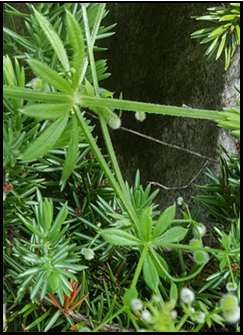
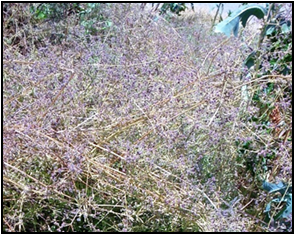
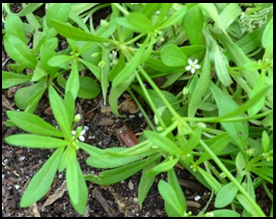
Hedge Bindweed (Calystegia sepium)
- Perennial. Vine growing to 10 ft. Tolerates poor soils; common in disturbed areas. Can produce chemicals that inhibit the growth of nearby plants.
- Leaves: (juvenile) heart-shaped, triangular, or sharply lobed at the base.
- Leaves: (mature) 2-4 in. long, alternate, triangular, with petiole and often without hairs. Leaves have a pointed tip with prominent, square, angular bases.
- Stems: trail along ground or climb up trees, may be with or without hairs.
- Flowers: 2-6 in. long, on long stalks, solitary, fused and funnel-like, usually white or pink. Two leafy bracts present at the base of the flower.
- Fruit: an egg-shaped to rounded capsule.
- Roots: rhizomes; removing the entire plant by hand once it is established is very difficult.
- Reproduction: by seed or rhizome.
- Often confused with Field Bindweed (Convolvulus arvensis) and Morning glory (Ipomoea purpurea). Field bindweed leaves are smaller and have a rounded, rather than a pointed, tip. The leaf bases of field bindweed are pointed or rounded with outwardly divergent lobes, rather than the squarely cut bases of hedge bindweed.
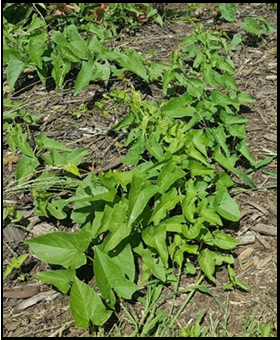
The seedling stage is the best time for removal (top right). Hedge bindweed flowers visible high in an evergreen tree (bottom right); foliage trailing on the ground (above). Photos by Alyssa Siegel-Miles.
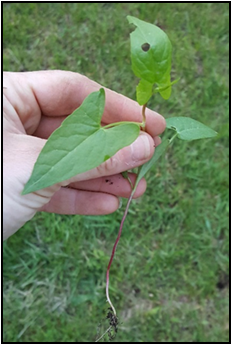
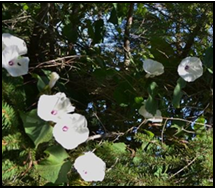
Common Chickweed (Stellaria media)
- Winter annual. Height to 16 in. Prefers shady, moist, fertile soil. Problem in both landscape beds and shady turf areas.
- Leaves: (juvenile) ovate with slender reddish hypocotyl, sparsely hairy.
- Leaves: (mature) opposite on the stem and oval or egg-shaped. Length 0.5-1 in., light green, smooth (possibly hairy at base and on petioles). Leaves at upper portion of branch are sessile, lower leaves have petioles. Leaves fold up at night and when it’s going to rain.
- Stems: weak, prostrate along the ground; roots at nodes when touching soil. Multiple branches. Slightly swollen at joints. Light green in color with lines of hairs in vertical rows that changes sides with each pair of leaves.
- Flowers: small (3-6 mm wide), white, (alone or in clusters) at ends of stems. 5 deeply-lobed petals (heart-shaped). Blooms March to August.
- Fruit: oval capsule, whitish in color.
- Roots: shallow and fibrous.
- Reproduction: by seed; germinates in early spring and late summer, sometimes throughout summer.
- One or two generations can be produced each year.

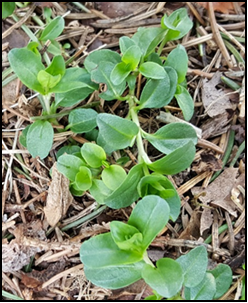
Mouse Ear Chickweed (Cerastium fontanum ssp. vulgare)
- Perennial. Height to 20 in.; prostrate, mat-like growth habit. Prefers shady, moist or poorly drained, often-compacted soil.
- Leaves (juvenile): cotyledons round to ovate with few or no hairs at base of stalk.
- Leaves (mature): opposite, dull-green, .25-.75 in. long, oval to elliptic, sessile, simple, hairy on upper surface and underside veins. Multiple branches give appearance of dense mat.
- Stems: slender, 2 rows of dense hairs, roots at nodes when able to touch soil.
- Flowers: white, clusters of 3 at end of each stem. 5 deeply lobed petals, white flower. Flowers March to August.
- Fruit: curved cylindrical capsule, fruit .25-.5 in.
- Roots: fibrous and shallow.
- Reproduction: by seed, and sometimes by creeping stems that root from the stem joints (nodes).

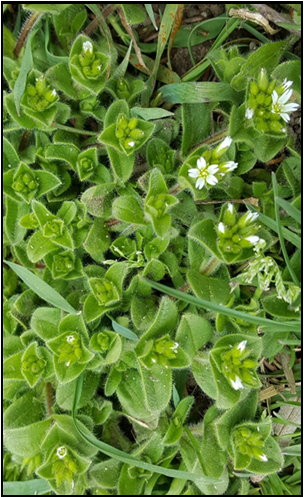
Henbit (Lamium amplexicaule)
- Winter annual. Height 4-15 in. tall.
- Leaves: .5-1 in. long; palmately-veined (3 or more veins emerging from a common point). Lower leaves have petioles, and are rounded to heart-shaped, with rounded teeth. Upper leaves are sessile, deeply-lobed, encircling the stem at the base. In the flowering portions, stem internodes are shorter and leaves can look whorled.
- Stems: square, green to purple, nearly hairless, prostrate or curved at the base, with an erect or ascending tip.
- Flowers: showy pink to purple, in whorls in the axils (between the stem and leaf) of the sessile upper leaves. Usually produced in April; may appear sporadically from March to November.
- Fruit: 3-angled, egg-shaped; brown with white spots, 2 mm long nutlets.
- Roots: fibrous; stems roots where the lower nodes contact the soil surface.
- Reproduction: by seed. Seedlings emerge from moist, cool soil in early spring and fall. Self-pollinated flowers may produce seeds without opening.
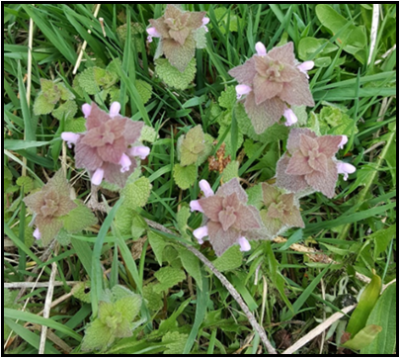
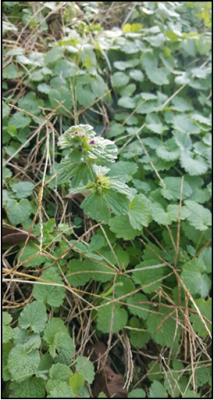
Horseweed (Conyza canadensis)
- Winter annual. Height .5-5 ft. tall; prefers disturbed areas.
- Leaves: (juvenile) rosette-like.
- Leaves: (mature) alternate, but very dense so almost appearing whorled; sessile, entire (not lobed), coarsely-toothed margins, hairy along edges. Leaves become slightly smaller as they ascend up the stalk.
- Stems: upright, hairy, and unbranched, except its flowering stem towards its apex.
- Flowers: aster-like at tip; dense inflorescence; heads of small, white ray flowers with yellow disk flowers, bracts at base. Self-pollinates.
- Fruit: small, elliptical, with off-white “dirty” bristles (dandelion-like fluffy hairs).
- Roots: shallow, short taproot with secondary fibrous roots. Easy to pull out of ground.
- Reproduction: by seed; germinates late summer or spring. Prolific seeder.
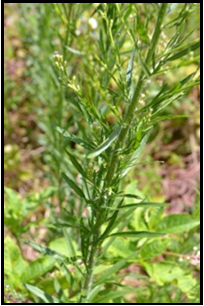
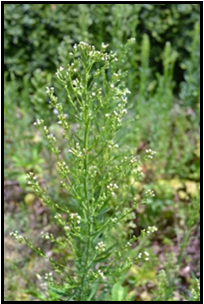
Horsetail (Equisetum arvense)
- Primitive, spore-bearing perennial. Height 6-24 in.
- Leaves: scale-like, resembling small conifer seedlings during summer; short sheaths with triangular teeth along upper rims, which become brown or black with age.
- Stems: 2 types - sterile and fertile. The fertile, spore-bearing stems grow in early spring and are not photosynthetic (superficially resembling brown mushrooms). Each fertile shoot is succulent, off-white, unbranched and 4-8 in. tall, terminating in a spore-bearing cone. The green, non-reproductive, sterile stems grow after the fertile stems have wilted and remain until the first frost in fall. They are smooth, slender, 6-24 in. tall, with jointed segments and whorls of ascending side shoots. The central stem is hollow.
- Roots: long rhizomes and fibrous secondary roots; often forming clonal colonies.
- Reproduction: primarily by rhizome; also possible by spore.
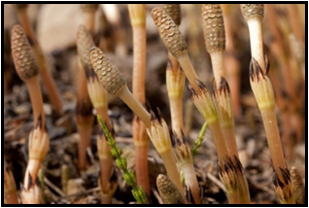
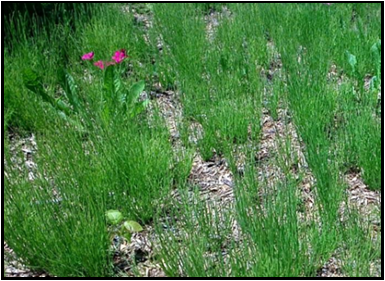

Japanese Knotweed (Fallopia japonica, syn. Polygonum cuspidatum)
- Perennial (CT invasive). Height 6-13 ft. Bushy appearance (many crowded stems). Grows along roadsides and in disturbed areas.
- Leaves: 5-8 in. long, alternate. The edge of the leaf blade is entire (has no teeth or lobes). Rounded leaf comes very suddenly to a point.
- Stems: smooth, noticeably jointed, hollow between nodes, reddish purple mottling, ocrea (tubular sheath) at nodes.
- Flowers: lacey, white in late summer to fall, in clusters of panicles.
- Fruit: 3-sided, shiny brown seeds enclosed in papery winged fruits.
- Roots: extensive rhizomes, quickly spreading to crowd out surrounding vegetation. Will regenerate from as little as 5 g. of stem or root tissue.
- Reproduction: primarily by rhizome, to a lesser extent by seed.
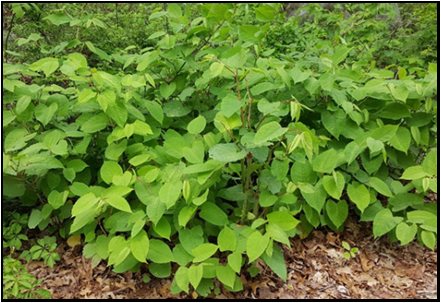
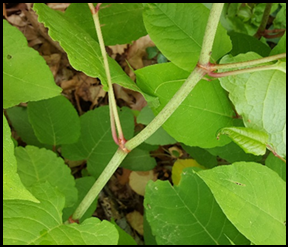
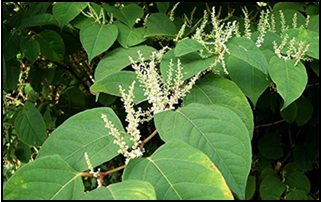
Image of flowers courtesy of naturespot.org.uk
Common Mugwort (Artemisia vulgaris)
- Perennial (CT invasive). Height 2-5 ft. tall. Grows in nitrogen-rich soils, such as roadsides, waste places, and uncultivated areas.
- Leaves: 2-8 in. long; alternate, simple, papery, with large pinnatifid lobes; undersides are covered with white to gray woolly hairs, dark green on upper surface. Foliage is aromatic. Leaves emerging from ground have shallower and broader lobes, whereas leaves on mid and upper portion of the plant have lobes that are more linear and more deeply pinnatifid.
- Stems: purplish-brown, branched, and covered with short hairs.
- Flowers: July to October. Inconspicuous; composite heads are clustered at terminal.
- Roots: rhizomatous; produce vegetative colonies.
- Reproduction: usually vegetatively by rhizome, rarely by seed.
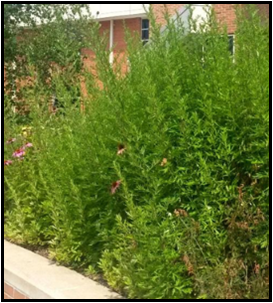
Colonization of mugwort.
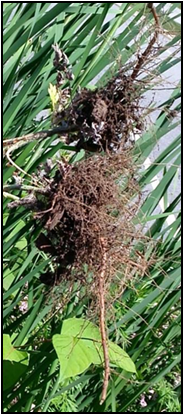

Common Ragweed (Ambrosia artemisiifolia)
- Summer annual. Height 1-6 ft. Health concern: potential allergen. Its pollen is a primary cause of hay fever. Does not tolerate frequent mowing. Grows in clay or sandy soil but prefers heavy moist soils.
- Leaves: (juvenile) thick, dark green, rounded above and narrow at the base; hairy; opposite.
- Leaves: (mature) become alternate as plant matures, with only some lower leaves remaining opposite. Pinnately compound.
- Stems: erect, branched, with long rough hairs.
- Flowers: present August to October. Produce large amounts of wind-dispersed pollen. Small, inconspicuous flower heads, green, in clusters on terminal branches. Male and female flowers on separate heads on plant. (Male more drooping at top plant, female flowers at upper base of leaves).
- Fruit: several long ridges ending in short spines; resembles crown.
- Roots: shallow taproot.
- Reproduction: by seed. Most germination occurs May to June. High soil temperatures (above 86 degrees F) inhibits germination.
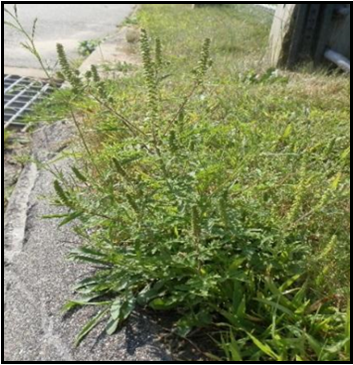

Spotted Spurge (Euphorbia maculata)
- Summer annual, spreading to 16 in. wide. Stems and foliage exude a milky sap when injured. Sap can be a skin irritant. Prefers infertile, compacted soils.
- Leaves: up to .5 in. long and less than half as wide, widest below the middle. Opposite, hairy, green, often with a maroon blotch on the upper leaf surface; on short petioles with stipules at the base.
- Stems: prostrate to ascending, mat-forming.
- Flowers: present from July to September in the axils of the upper leaves. Appear to be single, but are composed of several flowers in a cluster and are surrounded by a cup-like structure.
- Fruit: a 3-lobed capsule with stiff hairs on the surface.
- Roots: shallow taproot with secondary fibrous roots.
- Reproduction: by seed; germinates from early to late summer. Does not root at nodes. Seeds are produced when emerging plants are only a couple of weeks old.
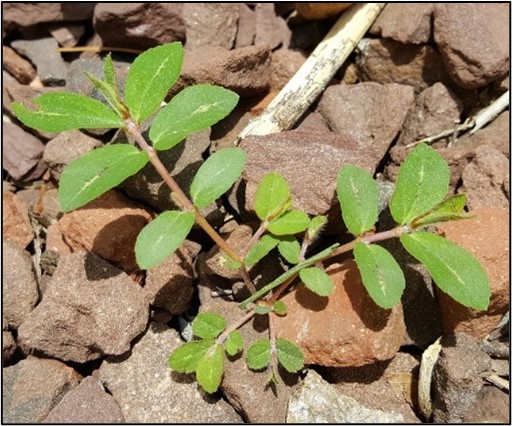
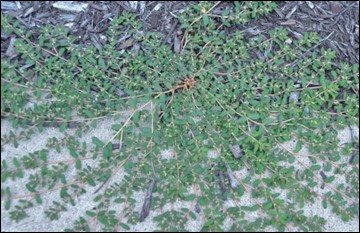
Canada Thistle (Cirsium arvense)
- Perennial (CT invasive). Height 2-4 ft.
- Leaves: alternate, sessile, irregularly-lobed with short, narrow, sharp spines on the margins. Young leaves covered with short hairs. Upper surface of leaves is dark green and hairless; underside is light green, and may be with or without hairs. The base of each leaf surrounds the stem.
- Stems: hairy (smooth when juvenile, becoming more pubescent as plant matures) and lack spines.
- Flowers: rose-purple or sometimes white appear in clusters on top of erect stems from June through October. Each flower head is a collection of tiny, tightly packed flowers; center flowers open last. Purple-tipped bracts enclose flowers before they open.
- Fruit: flattened achene (a small, one-seeded fruit containing a single seed), with feathery white plumes.
- Roots: extensive, creeping, fibrous; growing up to 3 ft. below the soil surface. Plants appear in patches or colonies.
- Reproduction: by wind-blown seed and creeping roots. Seeds germinate in late spring or early autumn.
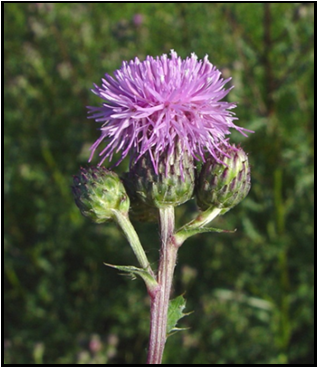
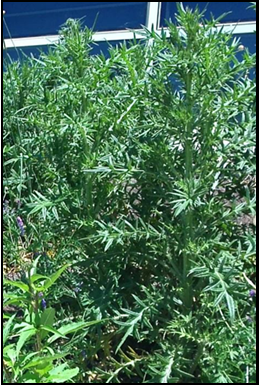
Annual Bluegrass (Poa annua)
- Cool-season winter annual. (Some types are biennial or perennial.)
- Bunch-type growth habit, prolific seed head production at any height, prefers moist/wet soils. Tolerates close mowing.
- Leaf: Boat-shaped tip of blade, light green in color; wrinkle across leaf blade.
- Stems: folded; long, membranous, white ligule with jagged tip; auricles absent.
- Seedhead: open, greenish-white pyramidal panicle, .75-2.5 in. long. Prolific seedhead production.
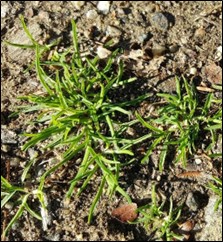
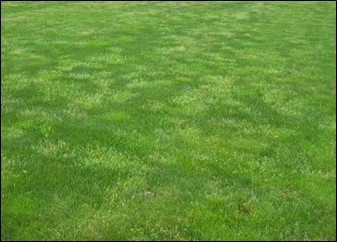
Large Crabgrass (Digitaria sanguinalis)
- Summer annual.
- Grows more quickly than turfgrass in summer. Prefers high fertility soils; tolerates low height of cut.
- Leaves: 2-5 in. long, 4-10 mm wide; sheath and blades hairy (stiff hairs at 90 degrees to plant surface). Collar is broad with long hairs at the margin. 1-2 mm jagged, membranous ligule. Leaves are pointed, flat and rolled in the bud, have a prominent midvein. Seedlings grow upright, then becomes more prostrate to ground as plant matures. Auricles absent.
- Stems: lie prostrate to ground with tips ascending, branches at lower node. Elongated stems root at the nodes and are flattened in cross-section.
- Flower/Inflorescence: develops at the tip of the stem and is composed of 2-6 spikes. Each spike is approximately 4 in. in length and flowers late summer to November.
- Seed: on spikelets, 2.5 mm in length, football-shaped, and have a stalk with a disk-like tip.
- Roots: fibrous and shallow-rooted.
- Reproduction: by seed and plant can root at stems. Seeds germinate mid-spring through late summer.
Note: this species is often confused with smooth crabgrass. Refer to pictures and description for distinction.
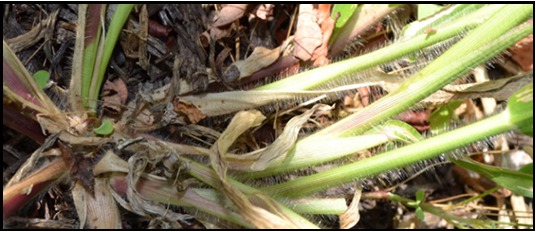
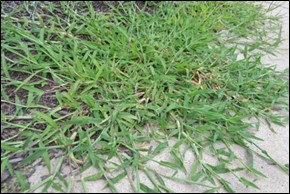
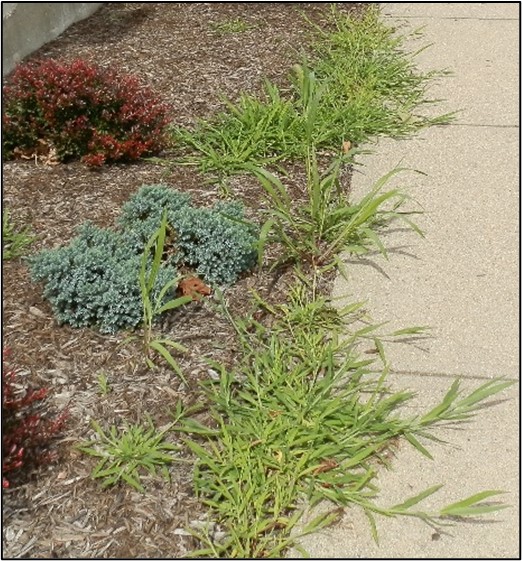
Yellow Nutsedge (Cyperus esculentus)
- Sedge (grass-like perennial).
- Prefers moist or poorly drained soils, but grows in many soil types.
- Leaves: yellow-green leaf blades are narrow, flat, shiny; have parallel veins that form grooves and ridges. Leaves are produced at the base of the plant in groups of 3, forming a sheath around the stem.
- Stems: 3-angled, triangular.
- Flowers: yellow-brown spikelet of terminal clusters, present July to September. Flowering stems are erect, unbranched, triangular in cross section, smooth, yellow-green, solitary.
- Reproduction: primarily by underground rhizomes and nutlets, making it difficult to eradicate new plants. Grows in clumps and spreads aggressively.
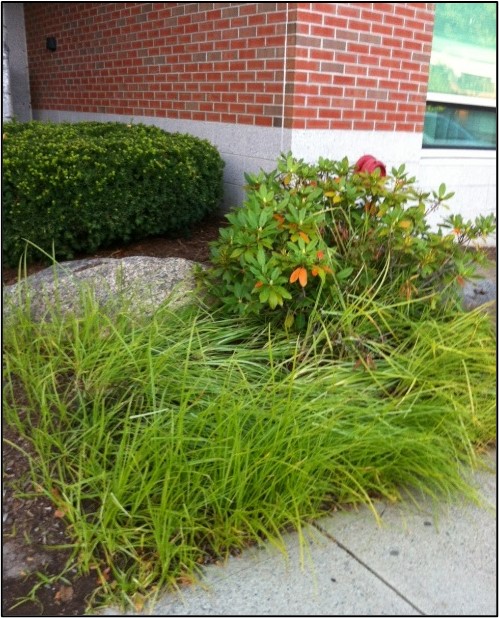
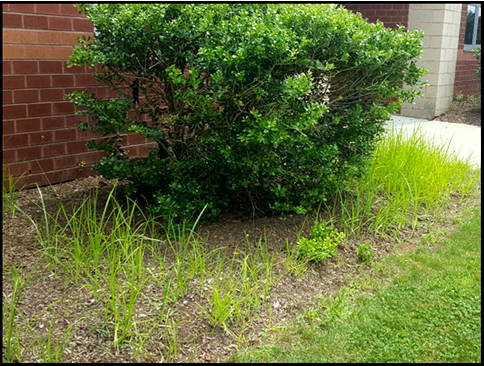
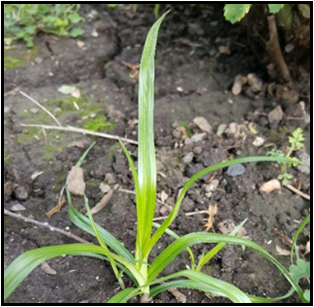
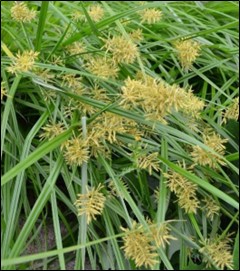
Oriental Bittersweet (Celastrus orbiculatus)
- Perennial, deciduous vine (CT invasive) that climbs, suffocates and strangles other plants.
- Leaves: alternate, 1-4 in. long, simple, round, pointed or round tip, bluntly toothed margins, glossy (not hairy). Yellow in autumn.
- Stems: green, climb for support, lack tendrils, and have obvious lenticels (raised pores).
- Flowers: small, inconspicuous; male and female flowers on separate plants.
- Fruit: a 3-valved, green outer capsule, maturing to yellow; casing splits open to reveal orange-red berry. Fruit poisonous to humans.
- Roots: orange; spreading lateral roots are up to .75 in. thick.
- Reproduction: by seed. Roots sucker aggressively, especially when plant is cut at soil line or pulled without removing all the roots. Very small, young plants can be pulled or removed without difficulty. Cutting a mature plant repeatedly at 1-2 ft. in height can eventually reduce its energy supply and kill the plant.

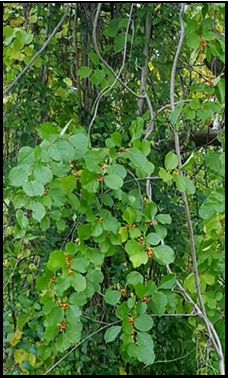
Japanese Honeysuckle (Lonicera japonica)
- Perennial (CT invasive). Semi-evergreen vine growing to 30 ft.
- Leaves: opposite, 1-3 in. long with untoothed margins. Shiny leaf top, pale underside. Rounded tip until it gets to a point. Pairs of leaves never joined (fused) at their bases, as are found in our native honeysuckle vines. Current year’s growth is hairy.
- Stems: hollow when mature.
- Flowers: showy, fragrant; white fading to yellow tubes almost 1 in. long. Flowers grow on young branches in pairs in the leaf axils (where leaf stem attaches to vine). Blooms June to October.
- Fruit: small black berries that mature in late summer to fall.
- Roots: vigorous runners that can grow 10 ft. or more per year and root at the nodes in moist soil.
- Reproduction: by seed and rapidly growing runners that root at the nodes.
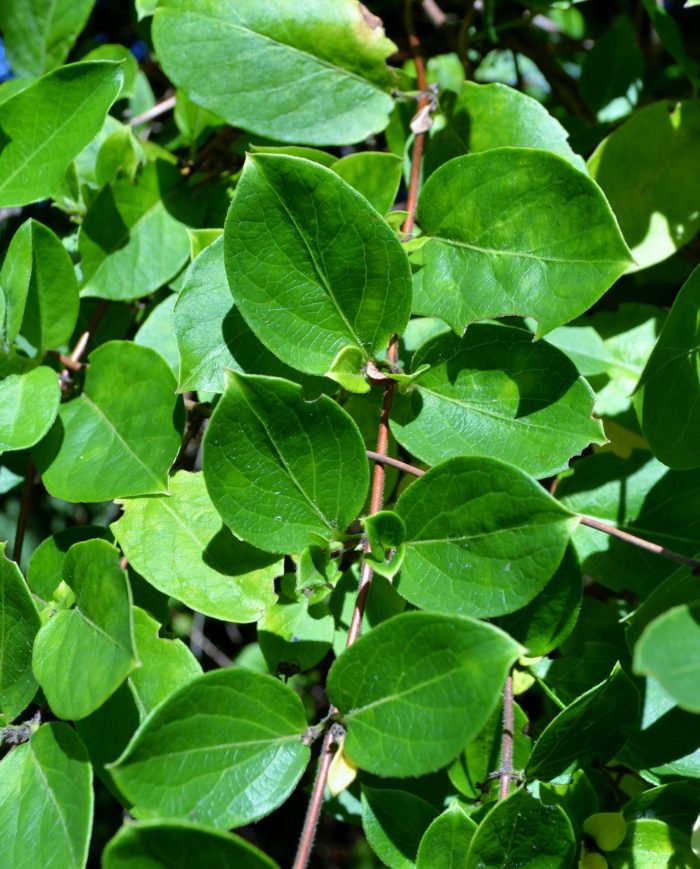
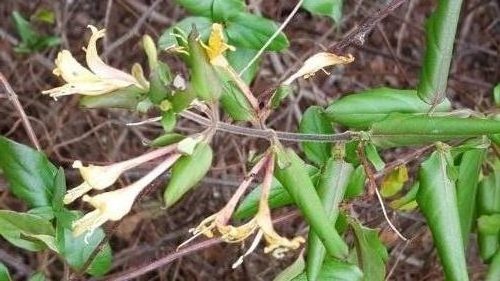
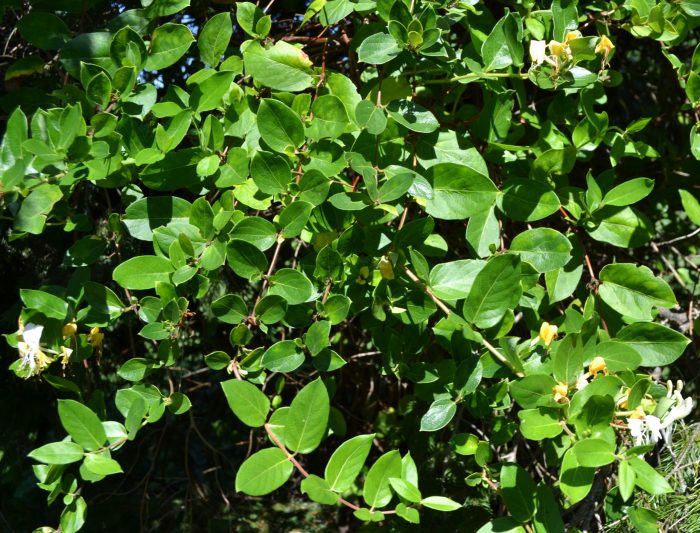
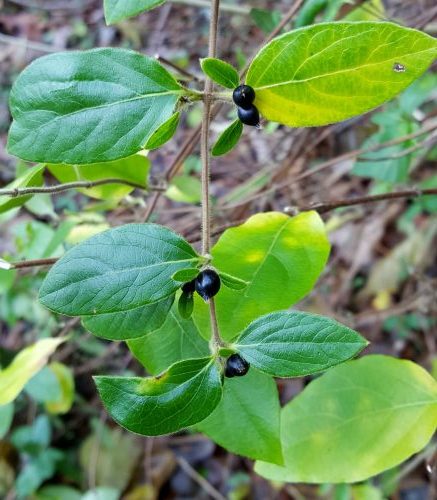
Poison Ivy (Toxicodendron radicans)
- Perennial, deciduous climbing or trailing vine or sometimes shrub. The major cause of allergenic dermatitis in the eastern U.S. All parts of the plant contain urushiol, a resinous compound that causes itching and rashes.
- Leaves: alternate; 3 shiny, light to dark green leaflets (red when young), each about 4 in. long, on its own stem. Middle stem is longer than side leaflet stems. Leaflet edges may be toothed, lobed, or entire (not lobed). Leaflets vary in shape; often egg-shaped. Yellow/orange/red fall color.
- Roots: adventitious roots and aerial rootlets that give the stems a hairy, fibrous appearance and allow vigorous attachment to neighboring trees, shrubs, or walls.
- Flowers: yellow/greenish white inconspicuous, in clusters above leaves; present in May to July.
- Fruit: white berry (drupe) that matures to a gray color; eaten and dispersed by animals.
- Roots: Creeping root stocks; stems that root where they contact the soil.
- Reproduction: by seed, creeping rootstocks, and stems that root at nodes. Seeds dispersed by birds.
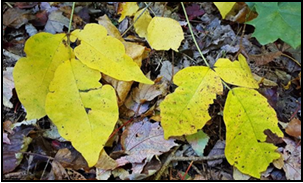
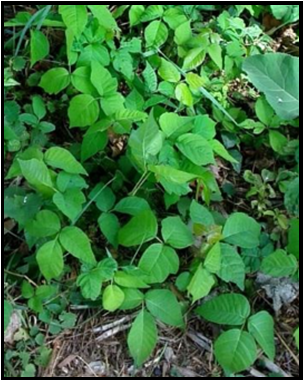
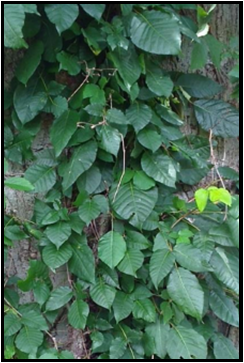
SPECIAL MENTION:
Common Milkweed (Asclepias syriaca)
- Native herbaceous perennial.
- Height 2-8 ft. All parts of common milkweed plants produce white latex when broken. Shoots emerge April to May.
- Leaves: 2.5-8 in. long and up to 5 in. wide. Opposite or sometimes whorled; simple, oval with a prominent white to red mid-vein, with smooth edges. They have very short petioles and velvety undersides.
- Stems: typically unbranched, erect, hollow; covered with downy hairs. Green, becoming red later in the season.
- Flowers: fragrant, nectar-filled occur in globe-like clusters (umbels), late June to early August. Individual flowers are purplish-pink to white, about .5 in. in diameter, each with 5 hooded petals above, 5 sepals below and styles united into a disk.
- Fruit: large (3-5 in. long) teardrop-shaped seed pods, opening in early autumn to hundreds of seeds, each with long, white silky hairs that aid in wind dispersal.
- Roots: Extensive system of thick, fleshy, white roots.
- Reproduction: by seed and creeping roots. Cultivation can easily fragment and spread roots.
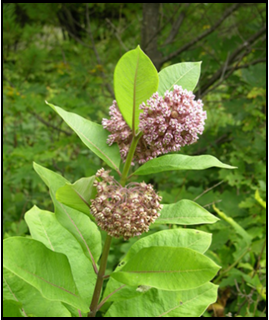


A common “weed” on many school properties. If volunteered into common areas or periphery of property, consider not removing. Monarch butterflies lay their eggs exclusively on milkweed plants, making them the sole food source for their larvae. The caterpillar stage feeds only on the leaves of plants in the milkweed family. In recent decades, the availability of milkweed for monarchs has been greatly reduced, due to changes in the urban and suburban landscape, which has contributed to a severe decline in the butterfly’s population.
Allowing milkweeds to grow on school properties, where it is not aesthetically unappealing and does not interfere with other plants, will provide a food source for monarch caterpillars and nectar supply for adult butterflies. Milkweeds are also important sources of nectar for dozens of other butterflies and numerous pollinating insects, including native bees and honey bees.
Milkweed usually grows in open fields, as it prefers full sun. It tends to grow in small colonies because it spreads vegetatively by rhizomes. If milkweed is growing in an undesired location, consider transplanting it to an outlying area of the school property if possible. Transplanting milkweed is tricky due to its taproot, but possible.
- Before transplanting, confirm it is milkweed and not a look alike, such as dogbane. Amend the soil with compost if needed.
- Transplant 1-2 plants as practice before transplanting many plants all at once.
- Transplant in early spring, when plants are young (before flower stalk emerges) or in late summer/early fall.
- For best results, dig deep and wide to get the entire root and avoid cutting the taproot. A small, 1-2 year old plant will transplant more easily than a more established plant with a deeper taproot.
- Keep the soil moist after transplanting. Protect the roots over winter with leaf mulch.
GLOSSARY OF TERMS USED IN THIS DOCUMENT:
Achene: a small, dry one-seeded fruit that does not open at maturity.
Alternate: leaf pattern arrangement is one leaf per node.
Annual: a plant that completes its life cycle from seed to mature plant in one year. Winter annuals complete their life cycles from fall to spring. Summer annuals complete their life cycle from spring to fall.
Auricle: a small projecting lobe or appendage found where the leaf blade meets the leaf sheath.
Collar: the area on the outer side of a grass leaf, at the junction of the blade and the sheath on the abaxial side of the leaf (away from the axis). The collar area is generally much lighter in color and varies in size and shape from species to species.
Compound leaf: divided into several leaflets.
Cotyledon: an embryonic leaf in seed-bearing plants, one or more of which are the first leaves to appear from a germinating seed.
Entire: with a continuous, untoothed margin (leaf description).
Hypocotyl: the part of the stem of an embryo plant beneath the stalks of the seed leaves, or cotyledons, and directly above the root.
Leaf blade: the leaf of grass or the broad portion of a leaf, as distinct from the petiole.
Leaf sheath: the basal part of a grass leaf, below the collar area, which encircles the stem.
Ligule: thin membranous appendage or ring of hairs on the inside of a leaf at the junction of the sheath and blade.
Node: the joint of a stem; the region of attachment of leaves to a stem.
Ocrea: papery sheath that encloses the stem at the nodes; made from the fusion of 2 stipules.
Opposite: leaf pattern arrangement is two leaves per node (where leaf comes from stem).
Perennial: a plant that lives for more than two years. Returns each year and continues growing until it reaches maturity (3-5 years on average).
Petiole: the stalk between the leaf blade and the stem.
Pinnatifid: more or less deeply cut with 2 rows of lateral appendages.
Rhizome: an underground, elongated stem (or shoot) with scale leaves and adventitious roots arising from the nodes.
Sessile: stalkless and attached directly at the base (ex. sessile leaf).
Simple leaf: a leaf blade that is all one piece; may be deeply lobed or divided, but not separated in leaflets.
Stipule: one of a pair of basal appendages of a leaf.
Stolon: an elongated stem (or shoot) that grows along the surface of the ground and from which leaves and adventitious roots develop at the nodes.
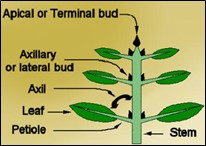
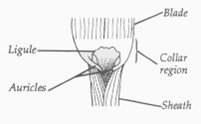
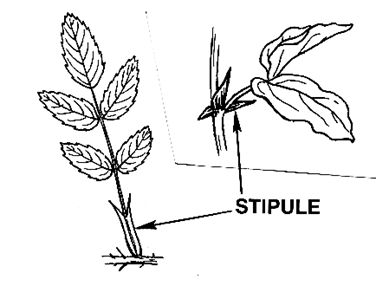
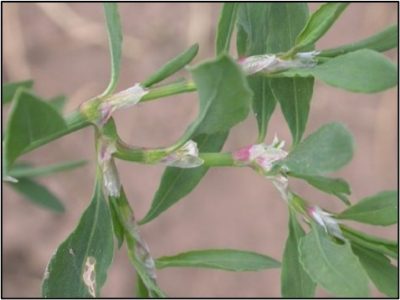
Bibliography:
- Connecticut Invasive Plant Working Group. (2018). Invasive Plant List. University of Connecticut Extension. cipwg.uconn.edu/invasive_plant_list/
- Milbrath, M. & Elsner, D. (2015). How to collect and grow milkweeds to help monarchs and other pollinators. Michigan State University Extension. canr.msu.edu/news/help_monarchs_and_other_pollinators_by_collecting_milkweed_seeds_this_fall
- Reicher, Z., Patton, A., Bigelow, C., & Voigt, T. (Rev. 2006). ID and Control of Annual Bluegrass ID and Control of Annual Bluegrass and Rough Bluegrass in Lawns and Rough Bluegrass in Lawns. Purdue Extension & University of Illionois Extension. extension.purdue.edu/extmedia
- Michigan State University Extension. (n.d.). Turf Weeds: Annual Bluegrass. msuturfweeds.net/details/_/annual_bluegrass_47/
- Turgeon, A. J. (2011). Turfgrass Management. Reston, Virginia: Reston Publishing Co.
- Uva, R., Neal, J. & DiTomaso, J. (1997). Weeds of the Northeast. Ithaca: Cornell University Press.
Questions? Contact:
Vickie Wallace
UConn Extension
Extension Educator
Sustainable Turf and Landscape
Phone: (860) 885-2826
Email: victoria.wallace@uconn.edu
Web: ipm.uconn.edu/school
©UConn Extension. All rights reserved.
Updated July 2020

